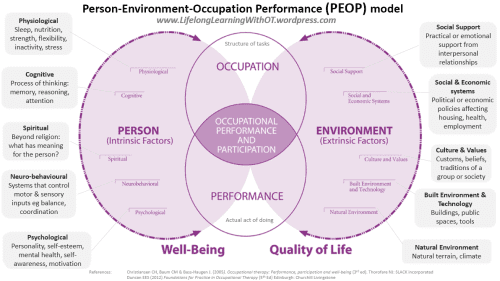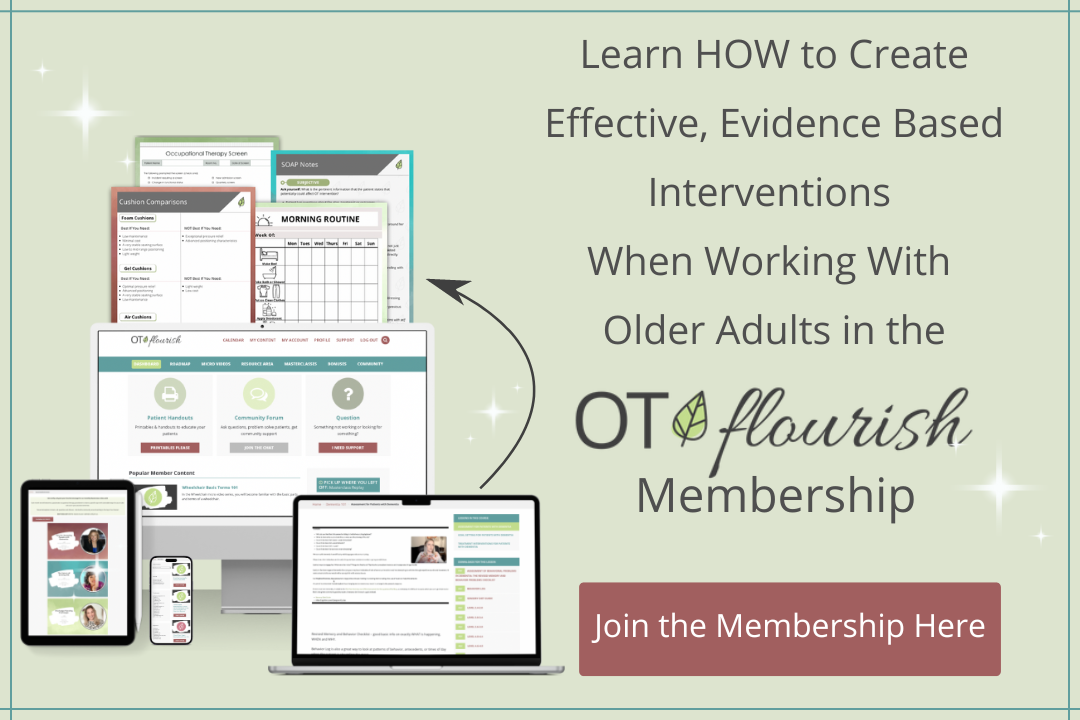By our very nature and the influence of our educational background, occupational therapists have to take a wholesome approach in therapeutic intervention. This means looking beyond the patient or client’s medical limitations and considering outside-of-the-box barriers and enablers related to occupational success. One of the dozen theoretical models that OTs learn in school that provides a basis for such a mindset is the Person-Environment-Occupation Performance or PEOP Model.
In this post, we will give a basic overview of what the PEOP model entails, give a PEOP example so you can understand how it is applied in occupational therapy practice and then talk a little bit about the pros and cons of the model.
Overview: What is PEOP?
The first thing to understand is that the PEOP model of occupational therapy (Christiansen and Baum, 1985) and the PEO model (Law et al., 1996) are not synonymous. Although both models have some similarities, PEOP holds to a handful of different principles.

The PEOP model highlights occupational performance as its key feature, which is made up of three interacting components (ach of their detailed characteristics which are listed in the previous image):
- person (client),
- environment, and
- occupation (i.e. activity, role, or task)
Inevitably, environmental factors will impact a person for better or for worse which determines the occupational performance outcome. If there is a healthy interaction between the person and their environment, then the person will experience success and improved well-being in occupational performance (Baum et al., 2015).
Since its original development in 1985, several revisions have been made to make PEOP more client-centered. This means that through a collaborative and supportive relationship between the client and the practitioner, the client’s needs and goals are highly vocalized and used in personal narrative form to determine the course of therapeutic care.
PEOP Model Example
Confused yet?
Below, we have created a practical case study in which the PEOP model is applied to see how it can be applied in practice:
Diana is a 54-year old patient who was admitted for a short hospital stay following a ground-level fall. She was attempting to transfer from her powered wheelchair to her bed at home when she slipped, resulting in a minor left shoulder fracture. After her hospital stay, she was admitted to a skilled nursing facility for further rehabilitation. She also has primary-progressive multiple sclerosis. Although she can stand for brief periods to perform transfers, she relies heavily on her powered wheelchair to get around at home and in the community. Diana’s priority goal is to get her left shoulder stronger so she can still perform her own transfers safely at home.
Through a comprehensive evaluation and collaborative conversations, Diana’s OT can identify factors in all three components of Diana’s overall occupational performance:
Environment
Social support:
Diana lives at home with her husband, who is retired and acts as her primary caregiver. However, her husband is aging and frail and struggles with physically helping Diana get around. She has two children who live out of state and rarely visit her.
Social and economic systems:
Diana has been medically involved in the healthcare system for many years. She has Medicare A, Medicare B, and a supplemental HMO insurance plan.
Culture and values:
Diana strongly values her own independence. She is also a devout catholic who attends church on a regular basis.
Built environment and technology:
Diana lives in a single-level townhome and owns a wheelchair ramp, a powered wheelchair, a shower chair, a transfer board, a walker, a fall alert home system, and a toilet riser. She also has grab bars installed throughout her home.
Natural environment:
Diana and her husband live in a city in the U.S. with easy access to flat terrain with sidewalks and other wheelchair accessible surfaces.
Person
Physiological:
Due to MS, Diana fatigues easily and has overall low muscle tone and body strength. The nature of her left shoulder fracture limits her range of motion and strength in upper extremity use.
Cognitive:
Diana has experienced some mild memory deficits within the last few years.
Spiritual:
Diana regularly attends catholic services and goes to bible study as often as possible.
Neuro-behavioral:
Due to MS, Diana has reduced sitting and standing balance as well as decreased sensation in her feet.
Psychological:
Although Diana is highly motivated to participate in therapy, she does have clinical depression.
After examining all of Diana’s unique environmental and personal factors, she, with the help of her OT, can create a tailored intervention plan to help her meet her functional transfer goals.
Pros to PEOP
- The emphasis on a client-centered approach allows the patient or client to develop goals for themselves based on their individual wants and needs.
- The comprehensive model lists out a wide array of factors that many OTs (especially new therapists) may not otherwise consider in intervention.
- It’s a very top-down approach, which takes the focus away from the client’s medical barriers and acknowledges both limitations and enablers in the client’s overall occupational performance.
PEOP Model Limitations
- According to the authors Christiansen and Baum (2015), there is currently no assessment tool that measures outcomes based on the PEOP model. So OTs are on their own using other tools to obtain relevant client information.
- Like a number of therapeutic models, PEOP could use additional evidence-based research to better support its principles in clinical practice.
We have also discussed a number of other occupational therapy models throughout the website including the Biopsychosocial Model here.
References
Baum, C. M., Christiansen, C. H., & Bass, J. D. (2015). The Person-Environment-Occupation- Performance (PEOP) model. In C. H. Christiansen, C. M. Baum, & J. D. Bass (Eds.), Occupational therapy: Performance, participation, and well-being (4th ed., pp. 49-56). Thorofare, NJ: SLACK Incorporated.
Occupation Models: PEOP (Person-Environment-Occupation Performance) (2015). Lifelong Learning in OT. https://lifelonglearningwithot.wordpress.com/tag/peop-model/. Viewed on January 30, 2020.
Post by Meredith D. Chandler, OTR/L, Freelance Content Writer and Mandy Chamberlain MOTR/L







